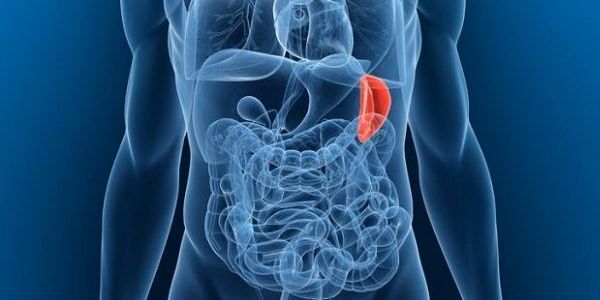Splenomegaly – treatment of disease. Symptoms and prevention of diseases of Splenomegaly

Splenomegaly – What is this disease? Splenomegaly is an increase in spleen, that is often the consequence of various diseases. In rare cases, splenomegaly is celebrated in pathological processes in the spleen.
Splenomegaly – The cause of the
The most common causes of splenomegaly are:
- Bacterial infections. So, splenomegaly occurs when tifo-paratifoznyh diseases, sepsis, miliarnom TB, tuberculosis of spleen, brucelleze, AIDS and other acute and chronic bacterial lesions.
- Viral infections. Increased spleen can be observed when Cory, Rubella, acute viral hepatitis, mononukleoze infection and other viral infections.
- Protozoal infections, such as malaria, toxoplasmosis, leishmaniasis and other.
- Mycosis-histoplasmosis and Blastomycosis.
- Helminthiasis. Splenomegaly can be observed in shistosomoze, echinococcosis.
- Different types of anemias: hemolytic, megaloblastic, gemoglobinopatii, cyclic agranulocytosis, idiopaticheskaya trombotsitopenicheskaya purpura, tromboticheskaya trombotsitopenicheskaya purpura.
- Systemic diseases of the blood, eg, acute and chronic leukemias, malignant lymphoma, Myelofibrosis and other.
- Autoimmune diseases.
- Disorders of the circulatory system.
- Inherited and acquired diseases of the metabolism.
- Focal lesion of the spleen.
Splenomegaly – Symptoms
Because splenomegaly is a consequence of many different diseases, There are no specific symptoms does not exist. Infectious and inflammatory splenomegaly may manifest fever, pain in left hypochondrium, as well as nausea, vomiting and stool disorder.
With regard to non-inflammatory forms of splenomegalij then they can manifest slight increase of temperature, weak pain in the left hypochondrium, and minor pain when feeling the left hypochondrium.
Splenomegaly – Diagnostics
Initially, the analysis of the complaints of the patient, medical history and examination. Dimensions are determined by palpation of the spleen and its density.
Among the laboratory studies conducted clinical and biochemical blood tests, coagulogram, general urine analysis, coprogram, the presence of feces parasites, as well as bacterial sepsis.
Instrumental research methods apply ULTRASOUND, as well as other types of diagnosis, depending on the presumed causes of splenomegaly. Available for sternal'noj puncture, CT, definition of autoimmune and biochemical markers, as well as genetic studies.
Splenomegaly – Types of disease
Splenomegaly sometimes inflammatory and not inflammatory. Inflammatory form of splenomegaly occurs when a bacterial, Viral, fungal, protozoal infections, sepsis, worm invasions and infarction of the spleen.
Nevospalitel'naja splenomegaly occurs without inflammation of the tissue of the spleen, but the deterioration of its basic functions. This form of splenomegaly occurs when anemia, Autoimmune processes, systemic diseases and metabolic diseases.
Splenomegaly – Actions of the patient
Unfortunately, splenomegaly can be asymptomatic for a long time. Upon detection of an enlarged spleen, you must identify and address causal disease, against which there is an increase in spleen.
Treatment
Treatment for splenomegaly, usually, boils down to eliminate the causative disease, caused an increase in spleen. Depending on the specific reason for treatment can be used antibacterial drugs, antineoplastic hormonal drugs, vitamins and other tools. For tumors of the spleen and gipersplenizma development is assigned to surgery to remove the diseased spleen.
Splenomegaly – Complications
Splenomegaly can lead to rupture of the spleen, as well as complicate Tez diseases, against which there has been an increase in spleen. In some cases there is a risk of development of gipersplenizma-reducing the amount of blood cells, platelets and leukocytes because of their destruction in the spleen.
Splenomegaly – Prevention
In respect of specific prevention splenomegalia does not exist. Renunciation of bad habits, timely vaccination and periodic check-ups with a doctor will lower the likelihood of this pathology.
